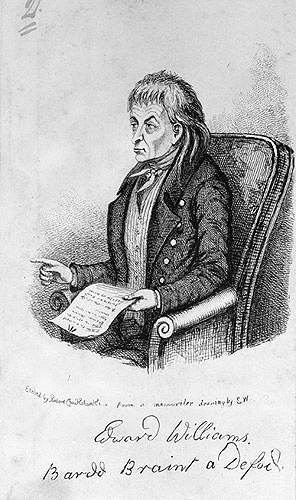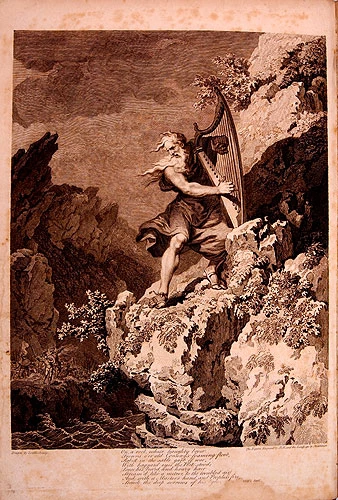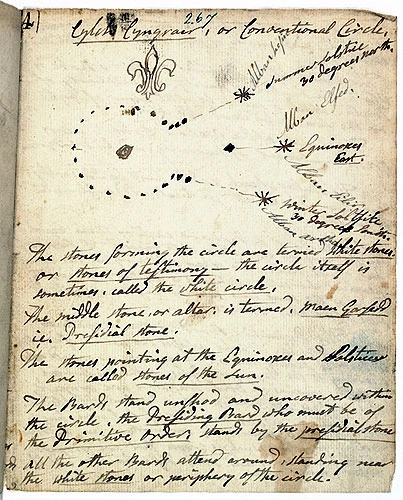'Our own pageantry and peacockry': the Gorsedd of the Bards
A portrait of Edward Williams, Ned of Glamorgan or Iolo Morganwg by George Cruickshank.
What is the Gorsedd?
The Gorsedd of the Bards of the Isle of Britain is a society of poets, writers, musicians, artists and individuals who have made a notable contribution to the nation, its language and culture. It operates through the medium of the Welsh language.
The Gorsedd of the Bards is responsible for the pageantry of the National Eisteddfod of Wales and it organises and presents the colourful and dramatic Proclamation and Gorsedd Circle rites, and the Chairing, Crowning and Prose Medal ceremonies on the main festival stage.
'The gorsedd is a sort of guild of literati and it provides at 'the national' the ceremonial aspect, the incantations, the robes of white, blue and green, the dancing elves, the sword of peace, the horn of plenty, the sheaf of corn. All the tribes of the world like ritual, badges, medals, strange hats, parades and archaic nomenclature and language. … Wales likes its own pageantry and peacockry …'
(Trevor Fishlock, Talking of Wales, London: Cassells, 1976, pp.75-6)
The inventor of the tradition: Iolo Morganwg
The Gorsedd is the product of the fertile imagination of Edward Williams, otherwise known as Ned of Glamorgan or Iolo Morganwg (1747-1826). He was born in the parish of Llancarfan, Glamorganshire, and although English was his home language he soon became interested in the Welsh language, its literature and history. He was a stonemason by craft and travelled throughout Wales and especially to London. Once there he came into contact with the Gwyneddigion Society and began to turn in cultural and radical circles.
Iolo Morganwg was a genius - one of the founder members of the Unitarian movement in Wales, a political radical who supported the French Revolution, a pacifist, an antiquarian, a hymn-writer and an able lyrical poet who called himself 'The Bard of Liberty'.
A Dreamer and a Forger
But he was also a dreamer and a forger. He was addicted to the drug laudanum and this probably affected his perception of the world. The creation of the Gorsedd of the Bards of the Isle of Britain was part of his dream and vision for Wales and Glamorgan and he managed to convince the scholars of his own time that it was a totally authentic institution. Why did he go to such trouble? There are a number of possible reasons:
- He was entranced by the romanticism of eighteenth-century neo-Druidism and he believed that Welsh poets had inherited the mantle of the Celtic druids.
- When he was in London he realised that the English disparaged the language of culture of Wales. Therefore, he decided to create a brilliant ancient past for his nation through the Gorsedd of the Bards of the Isle of Britain.
- Iolo was jealous of the Gwyneddigion's confidence that Welsh poetry and culture were at their purest in Gwynedd. Thus, he tried to prove that druidic traditions had survived only in Glamorganshire. As the scholar G.J.Williams has shown, 'The Gorsedd was an attempt at taking the wind out of the people of Gwynedd's sails … an attempt to show that they in Glamorgan had safeguarded the old Welsh institution in its original purity.'
- And, of course, Iolo was central to his own vision. He wanted to define a central role for himself in Welsh history through the Gorsedd of the Bards of the Isle of Britain.
Historian, Gwyn A. Williams crystallised Iolo's complex motives by claiming that he was driven by, 'a Welsh resentment against arrogant English, a south Wales resentment against arrogant northerners, a Glamorgan resentment against the rest and a Iolo resentment against any who snubbed him.'
When Iolo died in 1826 Wales had scarcely begun to fathom the full nature and extent of his invention and deceit.
from Costume of the Original Inhabitants of the British Isles (1815) by Samuel Rush Meyrick and Charles Hamilton Smith.
A plan of the Gorsedd Circle (the Conventional Circle) in Iolo Morganwg's handwriting. Note the comment 'the Bards stand unshod and uncovered within the circle'.
Druidmania
From the seventeenth to the nineteenth century British scholars were fascinated by everything Celtic. Druidmania flourished. One of the first to promote this interest was the antiquarian, John Aubrey, who suggested, in 1659, that the stone circles at Avebury and Stonehenge had been built by the Celts as druidic temples. Furthermore the Irish author, J.J.Toland, held a meeting for druids at Primrose Hill, London in 1717 and established The Ancient Druid Order.
In Wales Henry Rowlands (1655-1723), the Anglesey antiquarian, tried to prove, in his Mona Antiqua Restaurata (1723), that the cromlechi on the island were druidic temples. But when Iolo Morganwg visited Anglesey at the end of the eighteenth century he was disappointed at 'the exceedingly pitiful monuments of the Island' and he realised that this gave him a chance to promote the antiquities of Glamorgan instead.
The Archdruid and Druids of the Gorsedd of the Bards of the Isle of Britain today do not trace their origins back to the world of the Celtic druids, but the fact that the Gorsedd of the Bards meets within a Stone Circle demonstrates the influence of eighteenth neo-druidism upon its founder, Iolo Morganwg, and his lively imagination.
The First Gorsedd of the Bards of the Isle of Britain, 1792
The first-ever Gorsedd was held on midsummer's day, June 21, 1792, on Primrose Hill, London. A second Gorsedd was held on September 22 and the Morning Chronicle presented an excellent report of the ceremony:
'Saturday, Sept 22, being the day on which the autumnal equinox occurred and consequently, in the phrase of Bardism, a Solemn Bardic Day, some Welch Bards, resident in London, assembled in Congress on Primrose Hill, according to ancient usage, which required that it should be in the eye of the public observation, in the open air, in a conspicuous place, and whilst the sun is above the horizon. The wonted ceremonies were observed. A circle of stone was formed, in the middle of which was the Maen Gorsedd, or altar, on which a naked sword being placed, all the bards assisted to sheathe it... On this occasion the Bards appeared in the insignia of their various Orders...'
Several further ceremonies were held in London and in 1795 Iolo returned to Glamorgan to hold his first Gorsedd in his native county. But the authorities thought that he was fermenting revolutionary activity and therefore it was not until after the end of the Napoleonic Wars, in 1815, that Gorseddau were able to begin to flourish properly.
Coelbren y Beirdd - The Bardic Alphabet
Coelbren y Beirdd was a false alphabet invented by Iolo Morganwg c.1791. He claimed that it was the alphabet of the Celtic druids and that it had 20 'letters' and 20 others to represent elongated vowels and mutations. It would be hewn on a four-sided piece of wood and these pieces of wood would be placed in a frame, so that each piece could be turned to read all four sides. The name for this 'book' was 'peithynen'.
Taliesin ab Iolo published a book, Coelbren y Beirdd, based upon his father's manuscripts, in 1840. The alphabet was popular with some poets and druids throughout the nineteenth century although others, such as Edward (Celtic) Davies (1756-1831), questioned its authenticity. By 1893 J. Romilly Allen, joint-editor of Archaeologia Cambrensis's comments in a letter to the Herald Bard reflected the general consensus of opinion regarding Coelbren y Beirdd:
'I think the so-called Bardic Alphabet a gigantic fraud … I don't believe you will find it repay you to look at these bogus alphabets and pseudo-Druidic antiquities as anything but but (sic) the most bare faced impostures.'





Comments - (2)
Dear Veronica, thank you for your comment,
We can certainly add you to the mailing list for the National Museum. You may also want to look on the National Eisteddfod website if you wish to sign up to their upcoming events.
Graham Davies, Digital Team.
Could you add me to your mailing list if you have one ?
I would be interested to know of future events.
Many thanks